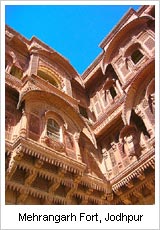| Jodhpur
Travel |
Introduction:
Jodhpur is at the edge of the Thar desert and is the largest
city in Rajasthan after Jaipur. The city is dominated by a massive
fort, topping a sheer rocky ridge right in the middle of the
town. Jodhpur was founded in 1459 by Rao Jodha, a chief of the
Rajput clan known as the Rathores. His descendants ruled not
only Jodhpur, but also other Rajput princely states. The old
city of Jodhpur is surrounded by 10 kms long wall, built about
a century after the city was founded. From the fort, you can
clearly see where the old city ends and the new begins. It's
fascinating to wander around the jumble of winding streets in
the old city, out of which eight gates lead. Jodhpur is affectionately
referred to as the ' Blue City ' because of the indigo-coloured
houses in the old town. These can be seen from the ramparts
of the mighty Mehrangarh, which looms high above the buzzing
city.
Sightseeing:
Jaswant Thada:
This white marble memorial to Maharaja Jaswant Singh II is a
short distance from the fort, just off the fort road. The cenotaph,
built in 1899, was followed by the royal crematorium and three
other cenotaphs which stand nearby. There is some beautiful
marble jali work and fine views from the terrace in front of
the cenotaph.
Mehrangarh Fort:
Situated on a steep hill, Mehrangarh fort is one of the largest
forts in India. The beauty and the grandeur of numerous palaces
in the fort narrates a saga of hard sandstones yielding to the
chisels of skilled Jodhpuri sculptures. Inside the fort, there
is a series of courtyards and palaces.
Umaid Bhawan Palace:
Built of marble and pink sandstone, this immense palace is also
known as the Chittar Palace because of the local Chittar sandstone
used. The only palace built in 20th century under the famine
relief programme, has now been converted into a hotel with some
parts being retained as a museum.
Mahamandir Temple:
Built in 1812, this is an old walled town with few hundred houses.
The temple with 84 beautifully carved pillars is an architectural
wonder.
Kailana Lake:
An artificial lake on the Jaisalmer road. An idyllic picnic
spot with spectacular sunsets. Leterally, the great temple,
a place where sacred glory reigns in a peaceful tranquility.
Situated on Mandore road, the temple is an architectural splendor,
supported by 84 pillars and ornamented with detailed designs
and figures depicting various postures of Yoga. The entire structure
is marked by a unique and original style.
Clock Tower & Sadar Market:
The clock tower is a popular landmark in the old city. The vibrant
Sardar Market is close to the tower, and narrow alleys lead
from here to bazaars selling vegetables, spices, Indian sweets,
textiles, silver and handicrafts. It is a great place to ramble
around at leisure.
Government Museum:
This museum has a rich collection of weapons, textiles, miniature
portraits, local crafts and images of Jain Tirthankars. It is
situated in the middle of the Umaid public gardens.
|
|
 |
| |
|
|
|
 |
All rights
Reserved. Best Viewed at 1024 x 768 using Netscape or Internet
Explorer version 5.0 or above.
Copyright ©2006-2007 CR License, LLC. All Right Reserved.
Terms of Use | Privacy Policy | Travel Agents |
|
|



